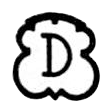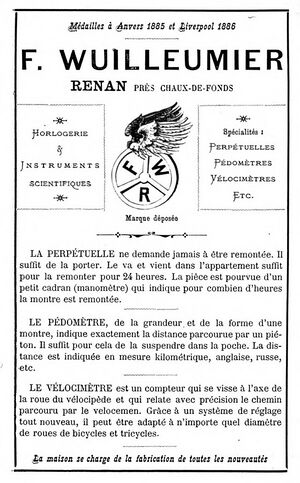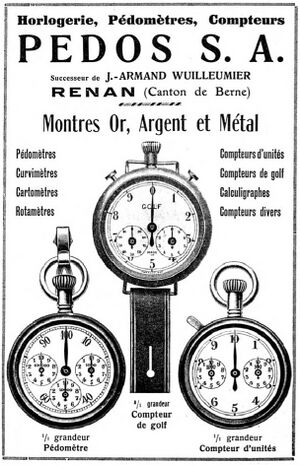Derby

Derby was a maker of ebauches in La Chaux-de-Fonds, part of Ebauches SA. The company is descended from F. Wuilleumier of Renan, which was later renamed Pedos and relocated to La Chaux-de-Fonds. Wuilleumier was a specialist in pedometers and created one of the first self-winding watches in the 1880s.
Wuilleumier

Wuilleumier Frères was perhaps the most important watchmaker to arise in Renan. Started in 1859, F. Wuilleumier specialized in timers and measuring devices. Indeed, as early as 1883, Félic. Wuilleumier was producing pedometers as well as watches in Renan.
An 1889 ad describes three important products of the company:
- LA PERPÉTUELLE never asks to be rewound. Just wear it. Get up and come into the apartment is enough to wind her up for 24 hours. The piece has a small dial (pressure gauge) which indicates for how many hours the watch has been wound.
- THE PEDOMETER, the size and shape of a watch, indicates exactly the distance covered by a pedestrian. All you have to do is hang it in your pocket. The distance is indicated in kilometer, English, Russian, etc.
- THE VELOCIMETER is a counter which is screwed to the axis of the wheel of the velocipede and which accurately reports the path traveled by the velocemen. Thanks to a brand new adjustment system, it can be adapted to any diameter of bicycle and tricycle wheels.
The company became known as Wuilleumier Frères by October 1892. Medals include Antwerp 1885, Liverpool 1886, Paris 1889, Chicago 1893, and Geneva 1890.
The company was registered as J.-Armand Wuilleumier on August 17, 1925.
Other Wuilleumier Frères Firms
A number of other unrelated companies existed under the name Wuilleumier Frères:
- Tramelan-Dessus, 1899-[[1966] (Later called Inula Watch Co. and Vuilleumier Frères)
- Graveur, La Chaux-de-Fonds, Rue du Coq 67, 1855
- Casemaker, La Chaux-de-Fonds, Soleil 15, 1877
- Watchmaker, La Chaux-de-Fonds (Jules-Edmond and Charles Armand Wuilleumier)
Pedos

The company changed its name to Pedos SA in 1929 to reflect its most popular product at the time. Administrators at this point were Louis Schorer of Wangen s. Aar and Fernand Hippenmeyer of Gottlieben. The company was headquartered at the J-Armand Wuilleumier factory in Renan. René Ruchti (-1970) of Büren joined Pedos management in 1931.
The sales offices for Pedos relocated to La Chaux-de-Fonds in 1932 along with Ollendorf Watch Co, with both sharing the same office at Rue du Parc 105 with sister company Orwa. But manufacturing remained in Renan until 1940. The company found modest success with pedometers and golf timers in the 1920s. In the 1930s, Pedos specialized in measuring and timing devices, including the calculigraphe, a 26 ligne calculation watch which replaces the slide rule, along with the cartometer, curvimeter, and pedometer. Pedos also offered a complete range of counters and chronographs, including a 12 ligne chronograph.
Pedos gained infamy as a target for Fidhor in 1934 and was convicted for violating export and price controls.
Exor, Ollendorf, and Orwa
Louis Schorer founded Exor on January 28, 1923. The company was located at Rue du Parc 105 in La Chaux-de-Fonds from the start before moving to Rue Neuve 11 in 1928, a few years before Schorer became involved with Pedos, Ollendorf, and Orwa at his old offices. Exor registered the Ever-Right brand in 1925 and warned others not to use it, but it is unknown today.
I. Ollendorf was a German immigrant to the United States who founded a watch counter in Pittsburgh that grew to become one of the largest and most important importers of watches in the United States. Later located on Maiden Lane in New York City, Ollendorf's operation was continued by his son, who often traveled to Germany and Switzerland seeking new stock. Ollendorf established an office along with Schorer's Exor in La Chaux-de-Fonds in 1928 on Rue Neuve 11. The companies would continue this collaboration for decades.
Louis Schorer founded another company, Joco Watch Co. (also called "Ioco"), at the same address on March 15, 1928. This company claimed to specialize in production, dealing, and exportation, of watches, movements, pendants, and jewelry. It was reorganized as Joco and Gotham Watch Co. in 1929. Gotham relocated to Parc 148 by 1942 but joined Exor at Rue de la Paix 23 by 1945 and shared its address with Exor and Ollendorf at Léopold-Robert 31a through at least 1957. Gotham Watch Co. of New York (perhaps a successor to Ollendorf) later owned the Ioco and Ollendorf brands into the 1970s.
In March 1931 Exor faced bankruptcy as the Great Depression impacted watch exporters. The team had recently taken over the Wuilleumier factory in Renan as well. Schorer and Ollendorf continued to press on, however. He re-paid all of his creditors and the company was officially listed as "rehabilitated" on November 16, 1938.
Orwa SA was a manufacturer of assortiments for anchor watches established in Renan in 1932. It is likely that it was created specifically to be acquired by watch industry trusts. The company was founded by the same management team as Pedos in this period: Louis Schorer, president, René Ruchti, secretary, and Fernand and Edgar Hippenmayer. The La Chaux-de-Fonds offices for Orwa were located at Rue du Parc 105, the same office that housed the renewed Pedos and Ollendorf. In 1941 the Swiss federal government provided a grant to resolve the issue of dissident watchmakers and Orwa's production of assortiments in Renan was purchased and closed. Both Orwa and Derby transferred their offices from Renan to La Chaux-de-Fonds on the same day (March 27, 1941), and both relocated their offices to Rue du Parc 148 that year as well.
Exor was reorganized again after World War II. On November 24, 1944, the company was divided equally between Louis Schorer, Louis-Ernest Schorer, and René Ruchti. At this point, the company also relocated to Rue de la Paix 23. Exor specialized in exportation of watches from various La Chaux-de-Fonds companies. Exor relocated to Avenue Léopold-Robert 31a in 1954, just four years before Orwa moved into the same building. Exor moved again by 1962 to Léopold-Robert 42. Brand names used by Exor include Exomatic, Exam, and Runwell. Exor was purchased by Zerholding SA of Lugano in [[1977].
Orwa SA was reconstituted on April 12, 1945, absorbing the assets of Jules Hirschy, Fabrique Montres Dulcia. The new company was managed by Henri Fer, president, along with Jules Hirschy and René Ruchti. The company moved to a temporary office at Rue du Côte 12, just as Derby came under Ebauches SA and moved to temporary offices in the former Election factory. Orwa took a permanent office at Rue du Côte 14 in 1946 and remained there for a decade.
Orwa established itself as a full watchmaker and brand after World War II. The company offered "all lever-watches automatic and chronographs" in the 1950s under the tagline "the right time for the best hours of your life."
Orwa moved to a new office at Avenue Léopold-Robert 31 in 1958, and the company remained there through the 1970s. In 1981 Orwa relocated just down the avenue to number 41. The company likely did not last long into the 1980s, however.
Derby
Pedos gave way to Derby in 1939, relocating the headquarters to La Chaux-de-Fonds in 1941, and leaving no serious watchmaking activity in Renan. After the Fidhor lawsuit, Derby was forced to reorganize and accept the control of Ebauches SA. The sole administrator of the company was Louis Schorer (1890-1955), with Fernand and Edgar Hippenmeyer, Ernest Schorer, and René Ruchti removed. Derby was originally located at Rue du Parc 105 alongside Ollendorf. But Derby and Ollendorf switched addresses with Levaillant Novelti, taking Parc 148 in 1941. Derby suffered due to the war in Europe and laid off all 70 workers in 1944. This left La Chaux-de-Fonds with no ebauche manufacturing, a serious concern for the city's watchmakers.
Ebauches SA soon purchased the Derby tooling, stock, and corporate assets as it had done with so many other ebauche makers a decade earlier. Derby SA was reorganized in 1946, with Louis Schorer remaining as president and Henri Jeannot of Brenets, Virgile Juillerat of Granges, and Charles Gschwend of Bienne added. Ebauches SA liquidated all remaining stock of Derby watch movements, deeming them substandard quality, but restarted production of curvimeters and a 5.5 ligne cylinder movement at Rue du Paix 157a, the former Election factory. But this made up only a tiny portion of the output of Ebauches SA. When Philips Radio asked to take over the entire factory complex in September, the holding company again considered closing the firm entirely.
Instead, Ebauches SA procured a factory building across town. This "new factory" was built for Manufacture Jurassienne around 1918 at Rue du Crêt 5, added to an existing building at Crêt 7. But Jurassienne failed around 1945, leaving the building vacant. Ebauches SA would use the building for Derby and its successors through the 1970s. This new building was too large and was initially leased to others while Derby's production grew. It featured a large Ebauches SA shield on the western wall with the "D" for "Derby", making it a landmark in the city. It was no doubt gratifying for chairman Louis Schorer to see his company return to become an active part of Ebauches SA by the time of his death in 1955.
Derby later found success as a specialist in electric and electronic movements as part of ETA, but the company continued to produce curvimeters into the 1970s, as pioneered by Wuilleumier before the turn of the century. It was run in later years by Paul Vogt (1914-1996).
Derby also produced the Derbyvox table alarm clock, Swisselectric line of clock radios, and DAC line of electric travel alarm clocks in the 1960s. Another unusual Derby product was the "G-Controler" which measured inertial force of acceleration when mounted to the dashboard of a car. Perhaps this could be used with a Memopark or Memostop. Derby also produced a telephone known as the Derbyphone at this time.
In 1968, Derby introduced Cal. 9120, sold by Ebauches SA under the ESA brand. It was a rectangular electric clock movement with an electromagnetic balance powered by a battery. It shared its electronic circuit with the contemporary Dynotron Cal. 9150 and replaced the ETA 2420, ESA 9000, and ESA 9100 movements. Derby was listed as being headquartered at Place de la Gare 4 in Neuchâtel by this point, as it was increasingly controlled by Ebauches SA rather than being an independent company. In 1973 Derby introduced a quartz marine chronometer, which ran for three years on a single 1.5 volt battery.
Swissonic and EEM
Ebauches Electroniques SA was established in 1969 as the production center for electric and electronic watches within Ebauches SA. On January 1, 1970, three major companies producing these components were merged: Derby SA of La Chaux-de-Fonds and Montilier and Neuchâtel, and the Fabrique d'Ebauches and Centre d'Outillage et Plastique of Landeron. It was decided to build a modern new factory to produce advanced watch movements in Marin near Neuchâtel, and this would give the company its common name: Ebauches Electroniques Marin, or EEM. The Marin factory opened in August, 1971, though the branches in La Chaux-de-Fonds, Landeron, and Montilier remained open for most of the decade.
By 1972 Derby was commonly called "Derby Swissonic", despite that brand also being used for other watches and movements. This was followed in 1974 by the introduction of a portable pen-shaped LED digital electric clock. Derby was also increasingly listed as being headquartered in Marin, and thus falling under EEM rather than being an independent company. As early as 1972 the La Chaux-de-Fonds operation was listed as a branch of EEM in employment ads.
In 1978 the Crêt 5-7 factory is listed in the Annuaire as Swissonic Ebauches Electroniques SA, as the Derby name had been retired and the company was a branch of EEM. This was changed to read simply "Ebauches Electroniques SA" in 1979 and 1980 and is no longer listed after this. In March 1982 it was announced that the Rue du Crêt 5-7 factory would be closed.